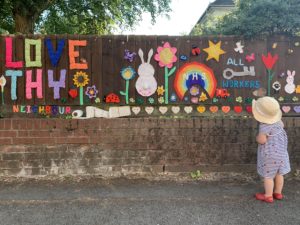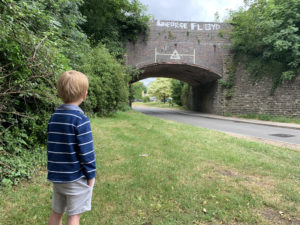The first in our series of Letters from Lockdown, written each week for our e-newsletter, is from Emily, our Benefice Administrator. This letter was originally published on Friday, 5th June 2020.
I took the photo you see on the left on Monday evening as I passed through a street in East Oxford. This is just a small snapshot of a homemade display that spanned half the length of the street. My children were captivated by the riot of colour, the texture of the crochet and the celebration of familiar things like the Royal Mail delivery van, the Easter Bunny and the NHS that they have learnt to clap for every Thursday evening. My son asked me what the large lettering spelt and I exclaimed ‘love thy neighbour’, pleased with the opportunity to effortlessly impart one of the ten commandments to him without the need to consider at length how best to deliver yet another lesson for life (ten weeks of home-schooling in lockdown has left me rather weary).
Just the day before, for the first time in months, the daily headlines broke away from COVID-19 commentary with reports of the death of a man in police custody in Minneapolis and the subsequent surge in large-scale protests across the states of America. In the days following, social media was flooded with displays of solidarity for our black brothers and sisters and pleas for us all to do more in the fight for racial equality. I’ve spent hours immersing myself in the commentary appearing on my news feeds, and listening to the voices that have finally been given space to be heard. If I’ve learnt anything from this week, it is that it is not enough to be non-racist, we must be anti-racist if social justice is to prevail for all. Being kind is good but being courageous is better.
On Tuesday morning, the residents of Horspath woke-up to the words ‘George Floyd’ graffitied on the side of the old railway bridge that spans the entry to the village green. Within hours, the village Facebook page became a forum for extremely divided opinions on our newly decorated bridge. How could the ‘de-facing [of] a historical landmark in a small village within the UK make any difference at all?’ began the thread. I watched the comments on the post first with amazement, then with sadness, then with anger and finally, with shame. Some claimed the name George Floyd meant nothing to them, some couldn’t see what a problem in America had to do with our village, some suggested such a protest should only be demonstrated outside the American Embassy in London and some hoped it wasn’t a message that needed emphasising here. As the comments flowed, so did white privilege. This man from America whose death had ignited rage across his state and country had no relevance or place here. The irony in some of the sentiments expressed made me silently weep.
I went to look at the bridge for myself. There, emblazoned in white paint reads the name George Floyd. It sits in the exact location as the words ‘Silver Jubilee ‘77’ that were painted on the bridge 43 years ago, just on the opposite side this time. Since the last painting in 1977, millions of cars have passed under that bridge. The person who boldly decorated the bridge in the dead of night at the start of this week didn’t seek to de-face, they sought to be heard, knowing full well the reach that their choice of location would have. If awareness was the aim, they have achieved this and then some. George Floyd’s name is meaningful. George Floyd’s life mattered. George Floyd’s death has sparked an outrage at racial injustice on a scale I have never witnessed in my lifetime.
On Thursday afternoon, I collected my nearly five-year-old son from school and took him to the bridge. I asked him if he could read the words. Not quite. I said George Floyd’s name aloud. He asked me who he was and in that moment I took my first committed step to being more than just non-racist but anti-racist. In George Floyd’s final gasping moments, he called for his ‘mama’. This is a name I hear hundreds of times each day and yet George Floyd’s cry for his nurturer, his comforter and his safe harbour touched me in a way that I never thought that everyday name could. I heard his call and I have work to do if the son of another mother is to be saved from the weight of the world on his neck. Yesterday I started with the education of my own son.
On Monday I encouraged my children to delight in the beauty and colour of somebody’s expression of love and gratitude for their neighbours and all that our society holds dear. On Thursday I chose to expose my eldest child to the very opposite of that – the hostile reality and fight for justice that so many face daily whether we see it directly in front of us or not. Looking at the ugly lettering and the now imperfect east side of the bridge feels uncomfortable yet the message is the same as the colourful crochet. There are no rainbows or flowers or smiling Easter Bunny adorning the letters on the bridge yet ‘love thy neighbour’ is still the directive I see. Which of these public displays provoked me to pick up my pen? Which one made me realise that my job of mama extends beyond the familiar and the comfortable? Which one finally made me think and understand the true meaning of white privilege? Which one made me want to love my neighbour not just by being kind when there is opportunity but proactive in the fight against injustices? While I want my children to see a world of love and kindness in full, bright, celebratory colour like the first photo, I’ve realised the only way to achieve this is to face the sad, stark reality of the second one if they are to ever understand that others experience the world differently to them and that we all have a role to play in moving beyond that.
I hope the person who made something ‘ugly’ to some knows that they made it meaningful for someone else. The bridge graffiti has opened my eyes that little bit wider and it’s given me the opportunity to open the eyes of my children for the very first time too. I hope when (and sadly I say when rather than if) they witness racism for the first time perhaps in the school playground or on a sports pitch or on a night out in years to come they will know to do more than just be passively kind. I hope they know how to use their white privilege for good rather than use it to turn away from someone else’s problem. A courageous stand might just make a difference to the person of colour stood next to them while laying another brick in the building of a better future for all who face racial inequity. If a splash of paint on a bridge started that, I hope it stays for the next 43 years and everybody that passes under it is reminded of their own responsibility to strive for racial justice because the work is here, there and everywhere.

